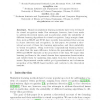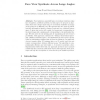631 search results - page 52 / 127 » Learning the Face Space - Representation and Recognition |
ECCV
2002
Springer
15 years 11 months ago
2002
Springer
Numerous statistical learning methods have been developed for visual recognition tasks. Few attempts, however, have been made to address theoretical issues, and in particular, stud...
AE
2007
Springer
15 years 4 months ago
2007
Springer
A simple mechanism is presented for the emergence of recognition patterns that are used by individuals to find each other and mate. The genetic component determines the brain of an...
AMFG
2005
IEEE
15 years 3 months ago
2005
IEEE
Pose variations, especially large out-of-plane rotations, make face recognition a difficult problem. In this paper, we propose an algorithm that uses a single input image to accura...
101
click to vote
ICMI
2009
Springer
15 years 4 months ago
2009
Springer
We have built a system that engages naive users in an audiovisual interaction with a computer in an unconstrained public space. We combine audio source localization techniques wit...
ICPR
2000
IEEE
15 years 2 months ago
2000
IEEE
Many realistic visual recognition tasks are “open” in the sense that the number and nature of the categories to be learned are not initially known, and there is no closed set ...


